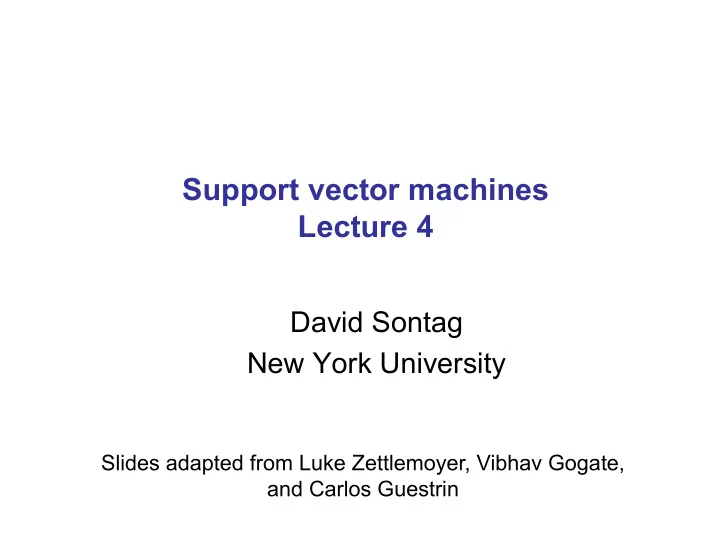

Support vector machines Lecture 4 David Sontag New York University Slides adapted from Luke Zettlemoyer, Vibhav Gogate, and Carlos Guestrin
Allowing for slack: “Soft margin” SVM w . x + b = +1 w . x + b = 0 w . x + b = -1 + C Σ j ξ j - ξ j ξ j ≥ 0 ξ “slack variables” ξ What is the (optimal) value of ξ j as a function ξ of w and b? ξ then ξ j = 0 If If then ξ j = Sometimes written as
Equivalent hinge loss formulation + C Σ j ξ j - ξ j ξ j ≥ 0 into the objective, we get: Substituting The hinge loss is defined as This is called regularization ; This part is empirical risk minimization, used to prevent overfitting! using the hinge loss
Hinge loss vs. 0/1 loss Hinge loss: 1 0-1 Loss: 0 1 Hinge loss upper bounds 0/1 loss!
How to deal with imbalanced data? • In many practical applications we may have imbalanced data sets • We may want errors to be equally distributed between the positive and negative classes • A slight modification to the SVM objective does the trick! Class-specific weighting of the slack variables
How do we do multi-class classification?
One versus all classification w + Learn 3 classifiers: w - • - vs {o,+}, weights w - • + vs {o,-}, weights w + • o vs {+,-}, weights w o w o Predict label using: Any problems? Could we learn this dataset?
Multi-class SVM w + Simultaneously learn 3 sets of weights: w - • How do we guarantee the correct labels? w o • Need new constraints! The “score” of the correct class must be better than the “score” of wrong classes:
Multi-class SVM As for the SVM, we introduce slack variables and maximize margin: To predict, we use: Now can we learn it?
Software • SVM light : one of the most widely used SVM packages. Fast optimization, can handle very large datasets, C++ code. • LIBSVM (used within Python’s scikit-learn) • Both of these handle multi-class, weighted SVM for imbalanced data, etc. • There are several new approaches to solving the SVM objective that can be much faster: – Stochastic subgradient method (up next!) – Distributed computation • See http://mloss.org, “machine learning open source software”
PEGASOS [ICML 2007] Primal Efficient sub-GrAdient SOlver for SVM The Hebrew University Shai Shalev-Shwartz Jerusalem, Israel Yoram Singer Nati Srebro
Support Vector Machines QP form: More “natural” form: Regularization Empirical loss term
PEGASOS A_t = S |A_t| = 1 Subgradient method Stochastic gradient 1 Subgradient Projection
Run-Time of Pegasos • Choosing |A t |=1 Run-time required for Pegasos to find ε accurate solution w.p. ¸ 1- δ • Run-time does not depend on #examples • Depends on “difficulty” of problem ( λ and ε )
Experiments • 3 datasets (provided by Joachims) – Reuters CCAT (800K examples, 47k features) – Physics ArXiv (62k examples, 100k features) – Covertype (581k examples, 54 features) Pegasos SVM-Perf SVM-Light 2 77 20,075 Reuters Training Time (in seconds): 6 85 25,514 Covertype 2 5 80 Astro-Physics
What’s Next! • Learn one of the most interesting and exciting recent advancements in machine learning – The “kernel trick” – High dimensional feature spaces at no extra cost! • But first, a detour – Constrained optimization!
Recommend
More recommend